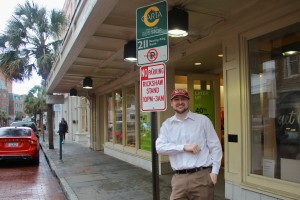#CofCMoves: Sean Bath Moves with CARTA
How do you move? Do you walk, bike, or use public transit? Join the Office of Sustainability and participate in the College’s first official event celebrating the different modes of transportation that the College community uses to commute to campus. On April 9th, during Sustainability Week, let us know how you move by using #CofCMoves and why you move the way you do!
We interviewed MPA/MES Grad Student Sean Bath about why he moves with CARTA.
Office of Sustainability: What is your role at the College?
Sean Bath: I’m a graduate student in the Public Administration and Environmental Studies dual degree program. I’ve been at the College since I started my undergraduate study in 2008.
OOS: Why do you use the bus rather than drive?
SB: There are many reasons. First, it saves me money. CARTA buses are free with a CofC ID and I don’t have to pay parking. Second, I can work, read, socialize, or nap on the bus. Not having to worry about driving is incredibly relaxing. Third, my girlfriend and I can share a single car without running up the mileage unnecessarily. Fourth, it promotes daily exercise with a purpose. I have a nice 10 minute walk to get to my home from the bus stop. Lastly, it significantly reduces my carbon footprint.

OOS: How long have you been doing so?
SB: I’ve been using the bus since 2012. The catalyst was the need to share the car and finding out that it was free to use CARTA, but it was the experience of using the bus that removed any anxiety or subconscious misgivings I had about it. Nowadays, I would continue using the bus even if I had to pay the fare — it’s still far cheaper than driving when you consider gas, wear and tear, parking, stress, etc.
OOS: How far do you commute daily?
SB: I commute about 6 miles from James Island. The express bus takes 20-30 minutes to get downtown, only stopping once, at MUSC. I choose to walk to the Wal-Mart bus stop, which takes me about 10 minutes, but the lot is designed for parking your car and using the bus to get downtown.
I commuted about the same distance via SC-61 when I lived in West Ashley for a year. That bus was normal service, with plenty of stops along the route. Travel times can vary depending on traffic and how many people are waiting at stops, but I’d say 30-45 minutes was the norm.
OOS: What are the benefits to commuting by bus versus driving alone?
SB: I’ve already mentioned several, such as reduced cost, reduced stress on the road, the ability to multi-task, and reduced carbon footprint. You also have the opportunity to meet interesting people and develop a sense of community.
OOS: What do you value most about the way you commute?
SB: I most value the sensation of being able to commute regularly for free. Ironically, there is a feeling of independence there. It also feels pretty good to reduce my carbon footprint without discomfort.
OOS: What is the biggest challenge you face as a commuter?
Personally, I’m lucky that my biggest challenge is reliability. I’d say 95% of trips are perfect or with slight delays, but the 5% of times when a bus never arrives can be crippling. I try to mitigate this by avoiding the last bus on a schedule, but it’s still pretty lousy to wait for the next bus. Those who live in more distant suburbs may have more trouble finding a nearby bus stop. Those at the end of a line can experience longer delays. Lastly, shelter at many bus stops is non-existent.
OOS: What are some improvements you’d like to see?
SB: I’d like to see them further improve the bus GPS tracker on the mobile website by making it a downloadable app with the ability to place alerts for incoming buses or for situations when a bus shuts down or is significantly delayed. Riders already get this information if they call CARTA, but an alert could save headquarters all the time answering phone calls while proactively informing app-users. App users could then tell other riders.
OOS: Are there any myths about Carta that you’d like to address?
SB: The biggest one is the idea that only lower income folks use CARTA. Yes, many of them do rely on it, but they’re not alone, especially with more students, faculty, and staff of MUSC and CofC taking advantage of the free ridership. CARTA ridership just keeps on growing. I’ve seen more than one person continue to use the bus after leaving these institutions.
I’d also challenge the notion that the buses are unsafe because of the other riders. I’ve never seen any aggressive behavior on the bus. There are security cameras installed in the buses and the drivers should intervene if anythingis called to their attention.
OOS: Would you recommend this method to others?
SB: Absolutely. Try it out and let it grow on you. Adapt to it and try to get rid of any anxieties you have by experiencing the normality of it. Then, be smart about it and figure out how to use the bus tracker to plan your walks to the bus stop: http://www.veoliavision.com/shadow/Predictions_Mobile.aspx?ccid=723
If you don’t feel comfortable trying it alone, try it with a friend.
OOS: Do you have any fun commuting stories?
SB: Twice I have had the opportunity to speak with candidates for Congressional office, one Republican and one Democrat. I’ve had great conversations with two separate Chinese post-docs working at MUSC, a mid-career student learning cyber-security, and many, many people from CofC. I’m mostly an introvert and I rarely talk to people on the bus. Still, every now and then a great conversation just happens. You see the sames faces every day. Even if you don’t exchange words, you share something.
